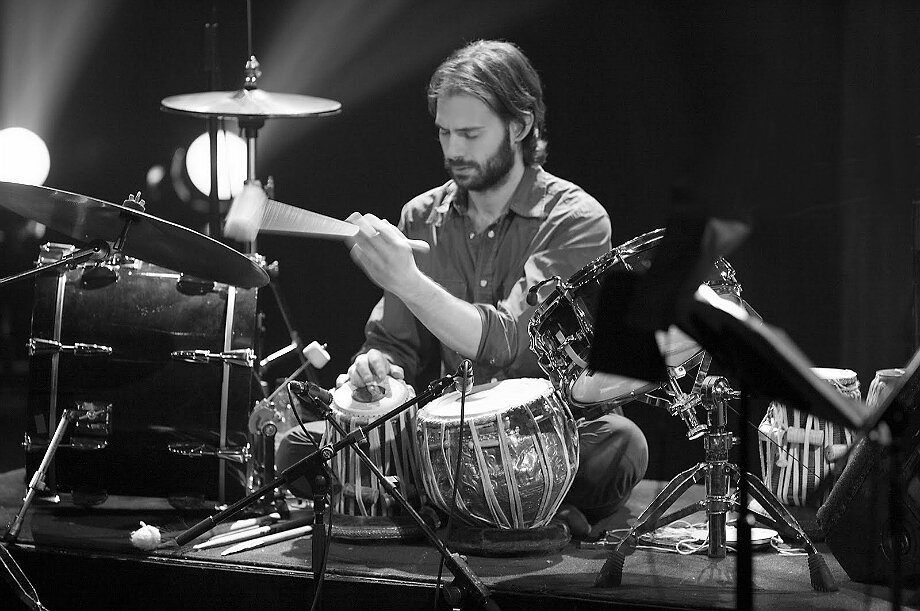Dan Weiss Speaks
 Dan Weiss is one of those drummers who's hard to mistake in a blindfold test. His snare zings through the mix like the sound of popping corn kernels; his cymbals interject with pinpoint precision. His unique sound is impeccably honed, drawing on not only jazz drummers past and present, but also his study of tabla and experience playing in metal bands like Bloody Panda. This unique sound has helped Weiss become one of New York's most in-demand sidemen, playing with the likes of saxophonists David Binney and Rudresh Mahanthappa, guitarist Joel Harrison, and trumpeter Amir ElSaffar.In 2010, with the release of his trio album Timshel (Sunnyside), Weiss showed that not only was his drumming finely honed, but his compositional voice as well. Weiss has followed up this critically acclaimed record with his most ambitious project to date: a long-form composition for large jazz ensemble called Fourteen, released on Pi Recordings last month. This weekend at The Jazz Gallery, Weiss and his collaborators from the album will perform the work as well as new, unrecorded pieces live for the first time. We caught up with Dan by phone this week to talk about how the piece came into being and his compositional process in general.The Jazz Gallery: What are the origins of Fourteen? How did you get started working on it?
Dan Weiss is one of those drummers who's hard to mistake in a blindfold test. His snare zings through the mix like the sound of popping corn kernels; his cymbals interject with pinpoint precision. His unique sound is impeccably honed, drawing on not only jazz drummers past and present, but also his study of tabla and experience playing in metal bands like Bloody Panda. This unique sound has helped Weiss become one of New York's most in-demand sidemen, playing with the likes of saxophonists David Binney and Rudresh Mahanthappa, guitarist Joel Harrison, and trumpeter Amir ElSaffar.In 2010, with the release of his trio album Timshel (Sunnyside), Weiss showed that not only was his drumming finely honed, but his compositional voice as well. Weiss has followed up this critically acclaimed record with his most ambitious project to date: a long-form composition for large jazz ensemble called Fourteen, released on Pi Recordings last month. This weekend at The Jazz Gallery, Weiss and his collaborators from the album will perform the work as well as new, unrecorded pieces live for the first time. We caught up with Dan by phone this week to talk about how the piece came into being and his compositional process in general.The Jazz Gallery: What are the origins of Fourteen? How did you get started working on it?
Dan Weiss: It started as just a couple of sketches. Right from the outside it felt like it was going to be a piece that was pretty large in scale in terms of instrumentation and in terms of intensity. I had a framework in my mind, and then I thought about what instruments I wanted to write for, and then when I had those in my head I started to hear the sounds of my close musical collaborators—their voices was what I had in my mind while I was writing. It was like a three-step process. In a way, it felt like the piece almost wrote itself.
TJG: Did it work in a cyclical process then—you composed music that made you think of certain players, which then affected how you composed later sections?
DW: Yeah, to some extent. When I would get their sounds in my head, they would dictate certain ideas. But I guess their sounds were in my conscious or subconscious mind the whole time.
TJG: Another thing I find interesting about this particular instrumentation is that there are lots of pairs of instruments—two saxophones, two trombones, two keyboards, two melodic plucked strings. Was this a conscious design, or just something that the music itself dictated?
DW: I don’t think it really was a conscious decision; it’s more just the way it happened. I know I wanted Jacob Sacks on piano, but I also knew I wanted some other keyboard sounds. In terms of the guitar and harp, I just think I was hearing another string sound on top of the original line I composed. The two saxophonists—Ohad Talmor and David Binney—are really close friends and collaborators. And for trombonists Jacob Garchik and Ben Gerstein, I’ve written for them as a pair in the past, and it seemed like a natural fit. And in terms of the three voices on the project, I wanted a bit of a choir thing.
TJG: The vocal writing on Fourteen is one of the most distinctive aspects of the record for me. You’re known for working with the human voice, but in a different way through your drum improvisations based on human speech. Does your vocal writing on the record come from the same place as your work with the rhythms of speech?
DW: That’s a good question. I’ve been into this speech contour thing for a long time. I used to record movies on cassette tapes and listen to them in my car and try to learn them, like Full Metal Jacket or Glengarry Glen Ross. But I don’t think there’s a direct correlation between that and my writing for voice. When I’m playing along to human speech, I’m trying to pull melody and rhythm out of them—and form, in a certain way—but in this project, I felt I was writing for voice in a pretty traditional way. Their lines are pretty instrumental-like. I was just trying to write good melodies.
TJG: In terms of larger formal design, was each section conceived on its own and then put together like a puzzle, or did you conceive the music as an organic whole?
DW: It’s definitely conceived as a whole. In the mastering process, I had to go back and add the track markers at certain points for practicality. There were definite points where the piece breathes, and so it ended up making sense to put separations in.It really is one piece and I wrote it as such. I knew from start to finish I wanted to juxtapose different levels of intensity. I wanted to have really spare parts and really dense parts, loud parts and gentle parts.
TJG: So when you’re working with a big form like this, how do you make sure when composing that the whole thing hangs together? Are there threads and motives that you keep bringing back, or is the crafting process more intuitive?
DW: There’s definitely an aspect of using threads to keep the whole thing together—there are a couple of themes that come in and out. There are these beat cycles that are repeated in and out. It’s something I like to do that comes more from classical music.But overall, I think there was more of an intuitive feeling when writing Fourteen. I was thinking a lot about contrasting elements, and about what kinds of sounds I want to hear next—like, do I want to hear some kind of improvisation next; do I want to hear a new instrument that I haven’t heard yet; what kind of register do I want to hear; do I want to hear a lot of cymbals or a lot of skins in the drum part; what do I want the bassist’s role to be? It’s like improvising, but at a much, much slower pace, I guess.Sometimes when I’m working on something, I’m writing from point A to point Z. Sometimes the material doesn’t come chronologically. I usually just feel out those things and try to get the basic architecture while I go. If it doesn’t feel right when I listen back, like using a MIDI realization, I go back and tweak those things, whether it be transitions, or rearranging the order of sections, stuff like that.I think trying to tell stories is what I do. When I’m improvising a solo or writing a piece, I like to create characters that reappear and change over the course of it. It’s as simple as that.
TJG: The piece reflects your huge range of musical experiences and reference points. There are these intense sections that are reminiscent of metal and these rhythmic cycles from Indian classical music and certain textures that are associated with contemporary classical music. When you have so much music floating around in your head, how do decide that certain sounds and gestures will work together in a piece?
DW: You try to make the whole thing organic and try not to force the issue. You can think of all of these things as a lot of different colors that you can put on your palette and the more music you listen to and the more open-minded you are about things, the more colors you have at your disposal. Whatever you play or write, it’s going to come out in a certain way based on what you’ve listened to and what’s in your brain at any given time.I like a lot of different kinds of music. A lot different styles speak to me, whether it’s Indian classical music, the whole spectrum of jazz, or the classical composer Morton Feldman, or Meshuggah, or any kind of rap. They’re all just there, and it’s not so much a conscious effort to include those musics, but the spectrum is wider. To some degree it’s a process that you don’t have much control over; it all just comes out.One of the reasons I listen to a lot of music is to equip myself with a lot of information—whether equipping myself for the compositional process, or equipping myself for when I play. It’s kind of like athletic training in a way. When athletes are playing, they aren’t thinking about the sprints that they were doing, or those layups, or whatever. You do all those things to forget about them so you can be in the moment. With listening, I’m training my brain, and then I can call upon those sounds and gestures that I’ve learned when I need them.
Dan Weiss celebrates the release of his album Fourteen (Pi) on Friday, April 11th & Saturday, April 12th, 2014 at The Jazz Gallery. The group features Weiss on drums, Jacob Sacks on piano, Thomas Morgan on bass, Miles Okazaki on guitar, David Binney on alto saxophone, Ohad Talmor on tenor saxophone, Ben Gerstein on trombone, Jacob Garchik on trombone & tuba, Matt Mitchell on glockenspiel, piano, & keyboard; Katie Andrews on harp, Stephen Cellucci on percussion, and Lana Cencic, Maria Neckham, and Judith Berkson on voice. Sets are 9 and 11 p.m. each night. $22 general admission ($10 for members). Purchase tickets here.
